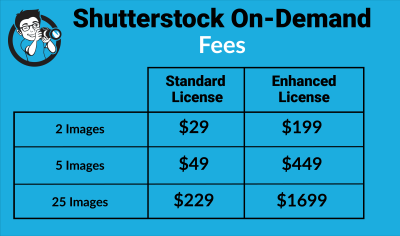Thinking about turning your photography passion into a paycheck? Shutterstock is a fantastic platform for new photographers to showcase their work and start earning. It’s like stepping into a global marketplace where your images can reach millions of potential buyers. Whether you’re just starting out or have a growing collection of photos, Shutterstock offers an accessible way to monetize your talent without needing a fancy storefront. In this post, I’ll walk you through how to get started, what to expect, and some tips to maximize your earnings. Let’s dive into the exciting world of stock photography and how you can make it work for you!
Understanding Shutterstock and Its Revenue Model

Before you jump in, it’s helpful to understand how Shutterstock operates and how you can earn money through the platform. Shutterstock is one of the largest stock photo agencies online, connecting photographers with millions of customers looking for high-quality images for websites, marketing, social media, and more. When you upload your photos,
Here’s how the revenue model works:
- Royalty-based system: When someone licenses your photo, you earn a royalty fee. The amount depends on your contributor level, the type of license purchased, and whether the buyer is a subscription user or a pay-per-download customer.
- Contributor levels: Shutterstock has a tiered system (Contributor, Contributor Plus, and Exclusive Contributor) that rewards more active and successful photographers with higher royalty rates and additional benefits.
- Payment thresholds: You can request payout once you reach a minimum balance, usually $35, via PayPal or Skrill.
Another thing to keep in mind is that Shutterstock values exclusive content—if you choose to license your images exclusively through them, you might enjoy higher royalty rates, but you’ll need to commit to not selling the same images elsewhere. Non-exclusive contributors can still upload to other platforms, giving you more flexibility but potentially earning lower royalties per download.
Overall, Shutterstock’s revenue model is designed to reward consistent contributors and high-quality work. Understanding these details helps you strategize your uploads, target popular themes, and gradually increase your earnings. It’s a game of patience and persistence, but with the right approach, Shutterstock can become a valuable income stream for new photographers like you!
Steps to Get Started as a New Photographer on Shutterstock
If you’re ready to turn your passion for photography into a source of income, getting started on Shutterstock is a fantastic move. The process is fairly straightforward, but there are some important steps to ensure you’re setting yourself up for success.
First, you’ll want to create an account. Head over to Shutterstock’s contributor page and sign up. You’ll need to provide basic information like your name, email, and payment details. Take your time filling out your profile because a complete profile helps establish credibility and trust with buyers.
Next, familiarize yourself with Shutterstock’s submission guidelines. Each platform has specific standards for image quality, content, and metadata. Make sure you understand what kinds of photos are in demand and what to avoid. Shutterstock provides helpful resources and tutorials to guide you.
Before uploading, organize your best work. Start with a portfolio of high-quality images that showcase your style and skills. When selecting photos, aim for variety—landscapes, portraits, lifestyle shots, and more—so you appeal to a broader audience.
When you’re ready to upload, follow these steps:
- Choose your best photos that meet Shutterstock’s quality standards.
- Upload images in the required formats and resolutions.
- Add accurate, descriptive titles and keywords—think like a buyer! Use relevant keywords to help your images get discovered.
- Fill in the necessary metadata fields to optimize searchability.
- Submit your images for review. Shutterstock’s review team will evaluate your submissions, which typically takes a few days.
Once approved, your photos will be live and available for licensing. Keep an eye on your dashboard to track your sales and earnings. Remember, consistency is key. The more high-quality images you upload over time, the better your chances of making steady income.
Tips for Creating High-Quality and Marketable Photos
Creating pictures that sell isn’t just about capturing a beautiful scene; it’s about understanding what buyers are looking for and delivering images that stand out. Here are some practical tips to help you craft marketable, high-quality photos:
1. Focus on Composition — Pay attention to framing, rule of thirds, leading lines, and balance. Well-composed images attract more attention and look professional.
2. Use Proper Lighting — Natural light is your best friend, especially during golden hour (shortly after sunrise or before sunset). Avoid harsh shadows and overexposed areas. When shooting indoors, use soft, diffused lighting.
3. High Resolution and Sharpness — Upload images with high resolution (at least 4MP or higher). Ensure your photos are sharp and in focus. Blurry or pixelated images won’t pass Shutterstock’s standards.
4. Keep It Relevant and Trendy — Stay updated on current trends. For example, lifestyle images that reflect diversity, sustainability, or new technology tend to perform well. Think about what buyers need now.
5. Edit Thoughtfully — Use editing tools to enhance your photos subtly. Adjust brightness, contrast, and color balance, but avoid over-editing or unnatural looks. Consistent editing style can also help establish your brand.
6. Avoid Common Pitfalls — Steer clear of overly staged or cliché images, busy backgrounds, or images with watermarks. Also, ensure you have the rights to all elements in your photos, including models and property releases if necessary.
Finally, diversify your portfolio. Upload a variety of subjects, styles, and themes to attract different buyers. The more high-quality, market-relevant images you produce, the better your chances of turning Shutterstock into a reliable income stream.
Optimizing Your Photos for Better Visibility and Sales
So, you’ve uploaded some great photos onto Shutterstock, but now what? Just like in any marketplace, standing out is key to making sales. Optimization is your secret weapon to improve your photos’ visibility and attract more buyers.
First off, think about keywording. When someone searches for a specific type of image, you want your photos to come up. Use relevant, descriptive keywords that accurately reflect what’s in your photo. Be specific—if you have a photo of a “sunset over the mountains,” include keywords like “sunset,” “mountains,” “nature,” “evening,” and “scenery.” Avoid vague terms or overstuffing with irrelevant keywords, which can hurt your ranking.
Next, pay attention to titles and descriptions. Your photo titles should be clear and straightforward, giving a quick idea of the content. Descriptions can add more context and include additional keywords, but keep it natural and helpful for buyers. Remember, people browsing Shutterstock want to find images that match their needs quickly.
Another tip is to focus on image quality. Higher resolution images that are well-lit, in focus, and free of noise tend to perform better. Shutterstock prefers professional-looking photos, so invest time in editing and retouching your images before uploading.
Don’t forget to analyze your performance. Shutterstock provides stats on how your photos are doing. If certain images aren’t getting views or downloads, consider updating their keywords or replacing them with better-quality shots. Also, keep an eye on trending topics—adding fresh content around current events or popular themes can boost visibility.
Finally, be consistent. Regularly uploading new content keeps your portfolio active and signals to Shutterstock’s algorithms that you’re an engaged contributor. Over time, this consistency can lead to higher rankings and more sales.
Best Practices for Uploading and Managing Your Portfolio
Managing your Shutterstock portfolio might seem overwhelming at first, but with a few best practices, you can keep things organized and maximize your earning potential.
First, create a workflow that works for you. Before uploading, gather all your best photos, perform quality checks, and do your keywording and descriptions in batches. This saves time and keeps your uploads consistent.
When it comes to file management, keep your images well-organized on your computer. Use folders categorized by themes, subjects, or shooting dates. This way, when you want to update or replace images, you can find them easily.
Always upload the highest quality versions of your photos, adhering to Shutterstock’s technical requirements. This usually means images should be at least 4 megapixels, in JPEG format, and without watermarks or borders. Clear, professional images are more likely to get accepted and sold.
As your portfolio grows, consider creating collections or categories within Shutterstock. Group similar images together—like nature shots, cityscapes, or business concepts. This not only helps you stay organized but also makes it easier for buyers to find related images.
Regularly review your portfolio’s performance. Remove or update images that aren’t performing well or are outdated. Keep your portfolio fresh by adding new content frequently. Remember, Shutterstock favors contributors who actively update their collections.
Finally, stay informed about Shutterstock’s submission guidelines and best practices. This helps you avoid rejections and ensures your images meet all quality standards. Participating in forums or community groups can also provide tips and feedback from fellow photographers.
By staying organized, adhering to quality standards, and engaging regularly, you’ll build a strong, professional portfolio that attracts buyers and generates steady income over time.
Strategies to Increase Your Earnings on Shutterstock
So, you’ve started uploading your photos to Shutterstock—great! Now, you’re probably wondering how to boost your earnings and really make the most of your portfolio. Don’t worry, there are some tried-and-true strategies that can help you grow your income steadily.
Firstly, diversify your portfolio. Upload a variety of images covering different themes, styles, and subjects. This way, you’ll appeal to a broader audience. Think about trending topics, seasonal content, and evergreen subjects like business, nature, or food. The more diverse your collection, the higher the chances of your images being purchased.
Next, focus on quality over quantity. High-resolution, well-composed, and properly edited images tend to perform better. Pay attention to lighting, focus, and composition. Remember, buyers are often looking for professional-quality photos, so invest time in editing and refining your images before uploading.
Another effective tip is to optimize your keywords and descriptions. Use relevant, specific tags that accurately describe your images. Think like a buyer—what words would they search for? The more precise your keywords, the higher the chances of your images appearing in search results.
Additionally, keep an eye on trending topics and seasonal events. For example, during the holidays, upload festive-themed images. During summer, focus on outdoor activities and travel shots. Staying current helps your images stay relevant and increases sales opportunities.
Consider creating exclusive collections or themed packs. This can attract buyers looking for cohesive sets or specific themes, encouraging bulk purchases and boosting your earnings.
Finally, engage with the Shutterstock community. Participate in forums, follow other successful contributors, and learn from their strategies. Sometimes, a small tip or feedback can make a big difference in how your images perform.
Remember, building a steady income on Shutterstock takes time and persistence. Keep uploading consistently, refining your approach, and experimenting with different styles. Over time, you’ll see your earnings grow as you develop a strong, recognizable portfolio.
Common Challenges and How to Overcome Them
Getting started on Shutterstock as a new photographer is exciting, but it’s not without its challenges. Many newcomers face hurdles like stiff competition, low initial sales, or uncertainty about what buyers want. The good news? With a little patience and strategic thinking, you can overcome these obstacles and thrive.
Challenge 1: Standing Out in a Crowded Marketplace
With millions of images available, it can be tough to get noticed. To stand out, focus on creating unique and high-quality content. Find your niche—whether it’s drone photography, macro shots, or conceptual images—and become known for it. Also, invest time in keyword optimization and compelling descriptions to improve your visibility in searches.
Challenge 2: Low Initial Sales
It’s common for new contributors to see slow sales at first. Don’t get discouraged! Keep uploading consistently, and pay attention to what sells. Use the sales data to refine your portfolio—remove underperforming images and focus on what buyers seem to prefer. Remember, building a reputation takes time.
Challenge 3: Understanding Buyer Preferences
Buyer needs can be unpredictable, and trends shift quickly. To stay ahead, regularly browse Shutterstock’s top-sellers and trending collections. Follow industry news and popular themes. This insight can guide your content creation to match current demand.
Challenge 4: Maintaining Consistent Quality
Quality is crucial. Invest in good equipment and editing software, and always review your images critically before uploading. Consider seeking feedback from fellow photographers or online communities to improve your work continually.
Challenge 5: Managing Expectations and Time
Success doesn’t happen overnight. Set realistic goals and allocate regular time for uploading, learning, and marketing your portfolio. Patience is key—building a passive income stream takes consistency and persistence.
In summary, challenges are part of the journey, but they’re also opportunities to learn and grow. Stay committed, adapt to market trends, and keep honing your craft. Before you know it, those hurdles will turn into stepping stones for your success on Shutterstock.
Additional Resources for Aspiring Shutterstock Photographers
Embarking on your journey to become a successful Shutterstock contributor can be greatly enhanced by leveraging a variety of helpful resources. These tools and platforms can improve your photography skills, optimize your submissions, and increase your earning potential. Here are some essential resources to consider:
- Photography Tutorials and Courses: Websites like Skillshare, Udemy, and Lynda/LinkedIn Learning offer courses on photography fundamentals, editing techniques, and niche specialization.
- Stock Photography Blogs and Forums: Engage with communities such as Photography For Beginners and the Shutterstock Contributor Forum to exchange tips, get feedback, and stay updated on industry trends.
- Editing Software: Mastering tools like Adobe Photoshop, Lightroom, or free alternatives like GIMP can significantly enhance the quality of your images, making them more appealing to buyers.
- Keywording and SEO Resources: Use keyword research tools like Keyword Tool or Ahrefs to improve your image descriptions and tags, increasing discoverability on Shutterstock.
- Analytics and Performance Tracking: Regularly review your Shutterstock dashboard and third-party analytics tools to identify which images perform best and tailor your future shoots accordingly.
By taking advantage of these resources, you can steadily improve your craft, understand market demands, and boost your earnings on Shutterstock. Continuous learning and community engagement are key to thriving as a new photographer in the stock photography industry.


